 W
WThe John F. Kennedy Space Center, located on Merritt Island, Florida, is one of the National Aeronautics and Space Administration's (NASA) ten field centers. Since December 1968, KSC has been NASA's primary launch center of human spaceflight. Launch operations for the Apollo, Skylab and Space Shuttle programs were carried out from Kennedy Space Center Launch Complex 39 and managed by KSC. Located on the east coast of Florida, KSC is adjacent to Cape Canaveral Space Force Station (CCSFS). The management of the two entities work very closely together, share resources and operate facilities on each other's property.
 W
WCape Canaveral is a prominent cape in Brevard County, Florida, in the United States, near the center of the state's Atlantic coast. Officially Cape Kennedy from 1963 to 1973, it lies east of Merritt Island, separated from it by the Banana River. It is part of a region known as the Space Coast, and is the site of the Cape Canaveral Space Force Station. Since many U.S. spacecraft have been launched from both the station and the Kennedy Space Center on adjacent Merritt Island, the two are sometimes conflated with each other.
 W
WThe Astronaut Beach House is a two-story house built in 1962 as a part of the then Neptune Beach subdivision at Cape Canaveral, Florida.
 W
WThe astronaut transfer van, known as the Astrovan during the Space Shuttle era, was a NASA vehicle used at the Kennedy Space Center to transport astronauts from the Operations and Checkout Building to the launch pad before a mission and for launch dress rehearsals, and back to the Operations and Checkout Building following a shuttle landing.
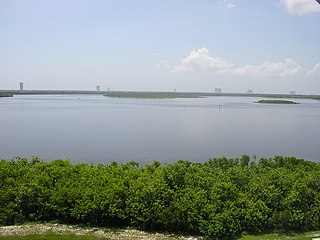 W
WCape Canaveral and adjacent Merritt Island on Florida's Atlantic coast are home to two American spaceports, one civilian and one military, servicing several active launch sites.
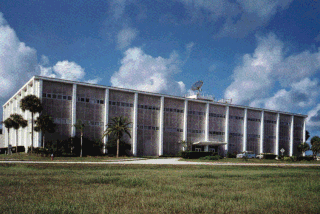 W
WThe Central Instrumentation Facility (CIF) was a building in the Kennedy Space Center industrial area that functioned as the core of instrumentation and data processing operations during the Apollo program and the early years of the Space Shuttle program. It centralized the handling of the center's data including offices, laboratories and test stations; and housed general instrumentation activities serving more than one launch complex. The CIF also included the Central Timing Facility, where a precision clock drove countdown clocks and other timing devices at KSC that required a high degree of accuracy.
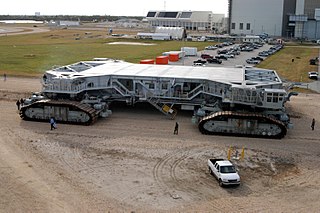 W
WThe crawler-transporters, formally known as the Missile Crawler Transporter Facilities, are a pair of tracked vehicles used to transport spacecraft from NASA's Vehicle Assembly Building (VAB) along the Crawlerway to Launch Complex 39. They were originally used to transport the Saturn IB and Saturn V rockets during the Apollo, Skylab and Apollo–Soyuz programs. They were then used to transport Space Shuttles from 1981 to 2011. The crawler-transporters carry vehicles on the mobile launcher platforms used by NASA, and after each launch return to the pad to take the platform back to the VAB.
 W
WThe Crawlerway is a 130-foot-wide (40 m) double pathway at the Kennedy Space Center in Florida. It runs between the Vehicle Assembly Building and the two launch pads at Launch Complex 39. It has a length of 3.4 and 4.2 miles to Pad 39A and Pad 39B, respectively. A seven-foot (2 m) bed of stones lies beneath a layer of asphalt and a surface made of Alabama river rocks.
 W
W W
WThe Kennedy Space Center Visitor Complex is the visitor center at NASA's Kennedy Space Center on Merritt Island, Florida. It features exhibits and displays, historic spacecraft and memorabilia, shows, two IMAX theaters, and a range of bus tours of the spaceport. The "Space Shuttle Atlantis" exhibit contains the Atlantis orbiter and the Shuttle Launch Experience, a simulated ride into space. The center also provides astronaut training experiences, including a multi-axial chair and Mars Base simulator. The visitor complex also has daily presentations from a veteran NASA astronaut. A bus tour, included with admission, encompasses the separate Apollo/Saturn V Center. There were 1.7 million visitors to the visitor complex in 2016.
 W
WThe KSC Headquarters Building is an eight-story office building that houses the administrative offices of NASA's John F. Kennedy Space Center (KSC). Constructed in April 2019, and also known as the Central Campus Facility, it incorporates the offices of the space center director, management staff, personnel, procurement and several hundred contractor and support workers. The building also houses the KSC Library, travel office, film and photo archives, photo processing shops, the Engineering Document Center, print shop, mail room, credit union and KSC security offices. The new eight story building houses 200,000 sq of floor space, filled with modern offices and its other facilities integrated into one roof, and has air conditioning and energy-efficient adjustable LED lighting installed throughout.
 W
WThe Launch Complex 39 Press Site is a news media facility at Launch Complex 39 at the John F. Kennedy Space Center (KSC) on Merritt Island, Florida where journalists have observed every U.S. crewed space launch since Apollo 8 in 1968. The site is just south of the Vehicle Assembly Building (VAB); 3 miles (4.8 km) west-southwest of Pad A, and 3.4 miles (5.4 km) southwest of Pad B.
 W
WThe Launch Control Center (LCC) is a four-story building at NASA's Kennedy Space Center on Merritt Island, Florida, used to manage launches of launch vehicles from Kennedy Space Center Launch Complex 39. Attached to the southeast corner of the Vehicle Assembly Building, the LCC contains offices; telemetry, tracking, and instrumentation equipment; and firing rooms.
 W
WThe Mercury Control Center provided control and coordination of all activities associated with the NASA's Project Mercury flight operation as well as the first Project Gemini flight, Gemini 3. It was located on the Cape Canaveral Space Force Station near Launch Complex 14.
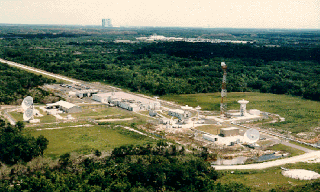 W
WThe Merritt Island Spaceflight Tracking and Data Network station, known in NASA parlance as MILA, was a radio communications and spacecraft tracking complex located on 61 acres (0.25 km2) at the Kennedy Space Center (KSC) in Florida. The name MILA was an acronym for the "Merritt Island Launch Annex" to Cape Canaveral Air Force Station, which was how the site was referred to when spacecraft launches were primarily originating from the adjacent military installation. MILA's arrays of antennas provided various communications and data services between spacecraft and NASA centers, as well as tracked and ranged moving spacecraft. In its final years, it served as the primary voice and data link during the first 7½ minutes of Space Shuttle launches, and the final 13 minutes of shuttle landings at KSC. Though it occupied land at KSC, MILA was operated and managed by the Goddard Space Flight Center.
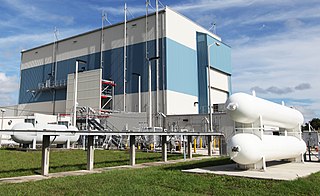 W
WThe Multi-Payload Processing Facility (MPPF) is a facility at Kennedy Space Center constructed by NASA in either 1994 or 1995 and used for spacecraft and payload processing. Prior to being assigned the role of processing the Orion spacecraft, the MPPF was used to process solely non-hazardous payloads.
 W
WNASA Parkway, also known as NASA Causeway, is an east-west expressway in Brevard County, Florida, containing two causeways. The first causeway connects the Florida mainland to Merritt Island and later, over the private second causeway, connects Merritt Island to Cape Canaveral. As such, the NASA Parkway is the main route connecting points of interest in Titusville, Florida to the Kennedy Space Center on Merritt Island.
 W
WThe NASA Railroad is a Class III industrial short-line railroad at the Kennedy Space Center in Cape Canaveral, Florida. The railroad consists of 38 miles (61 km) of track connecting the mainline of the Florida East Coast Railway and trackage at the Cape Canaveral Air Force Station.
 W
WThe Neil Armstrong Operations and Checkout Building (O&C) is a historic building on Merritt Island, Florida, United States. The five-story structure is in the Industrial Area of NASA's Kennedy Space Center. Its has twin-block facilities that include the crew quarter dormitories for astronauts, suit-up preparations prior to their flights, and the other is a large spacecraft workshop used for manufacturing and checking activities on crewed spacecraft. On January 21, 2000, it was added to the U.S. National Register of Historic Places.
 W
WOrbiter Processing Facility (OPF) is a class of hangars where U.S. Space Shuttle orbiters underwent maintenance between flights. They are located west of the Vehicle Assembly Building, where the orbiter was mated with its External Tank and Solid Rocket Boosters before transport to the launch pad. OPF-1 and OPF-2 are connected with a low bay between them, while OPF-3 is across the street.
 W
WThe John F. Kennedy Space Center, located on Merritt Island, Florida, is one of the National Aeronautics and Space Administration's (NASA) ten field centers. Since December 1968, KSC has been NASA's primary launch center of human spaceflight. Launch operations for the Apollo, Skylab and Space Shuttle programs were carried out from Kennedy Space Center Launch Complex 39 and managed by KSC. Located on the east coast of Florida, KSC is adjacent to Cape Canaveral Space Force Station (CCSFS). The management of the two entities work very closely together, share resources and operate facilities on each other's property.
 W
WRubber room is the nickname given to the emergency egress bunkers located 40 feet (12 m) beneath the launch pads at Kennedy Space Center Launch Complex 39; there is one below each of the two pads. Built in the 1960s for the Apollo program, and intended to provide a safe refuge for personnel on the launch pad in the event of an imminent explosion of the rocket, when a rapid egress of the pad is required and the normal evacuation methods would take too long. The bunker was designed to withstand the explosion of a fully fueled Saturn V rocket on the pad above, and could support up to 20 people for 24 hours.
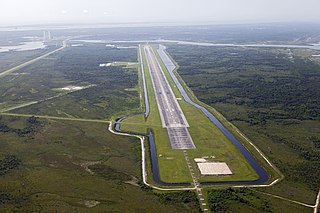 W
WThe Shuttle Landing Facility (SLF) is an airport located on Merritt Island in Brevard County, Florida, United States. It is a part of the Kennedy Space Center and was used by Space Shuttle for landing until July 2011. It was also used for takeoffs and landings for NASA training jets such as the Shuttle Carrier Aircraft and for civilian aircraft.
 W
WThe Space Coast Next Generation Solar Energy Center is a 10 megawatt (MW) solar photovoltaic (PV) facility at the Kennedy Space Center, Florida. Commissioned in April 2010, the center is the result of a partnership between NASA and Florida Power & Light. The facility has approximately 35,000 solar photovoltaic panels from SunPower covering an area of 60 acres. The facility provides slightly less than one percent of the power needed to keep Kennedy Space Center up and running.
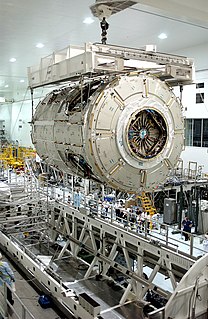 W
WThe Space Station Processing Facility (SSPF) is a three-story industrial building at Kennedy Space Center for the manufacture and processing of flight hardware, modules, structural components and solar arrays of the International Space Station, and future space stations and commercial spacecraft. It was built in 1992 at the space complex's industrial area, just east of the Operations and Checkout Building.
 W
WThe Spacecraft Assembly and Checkout Building was built in 1959 for a Department of Defense missile program. The facility was acquired in 1960 by NASA and modified for unmanned missions.
 W
WAs of 2020, SpaceX operates four launch facilities: Cape Canaveral Space Launch Complex 40 (SLC-40), Vandenberg Space Force Base Space Launch Complex 4E (SLC-4E), Kennedy Space Center Launch Complex 39A (LC-39A), and Brownsville South Texas Launch Site. Space Launch Complex 40 was damaged in the Amos-6 accident on September 2016 and repair work was completed by December 2017. SpaceX believes that they can optimize their launch operations, and reduce launch costs, by dividing their launch missions amongst these four launch facilities: LC-39A for NASA launches, SLC-40 for United States Space Force national security launches, SLC-4E for polar launches, and South Texas Launch Site for commercial launches.
 W
WThe Swamp Works is a lean-development, rapid innovation environment at NASA's Kennedy Space Center. It was founded in 2012, when four laboratories in the Surface Systems Office were merged into an enlarged facility with a modified philosophy for rapid technology development. Those laboratories are the Granular Mechanics and Regolith Operations Lab, the Electrostatics and Surface Physics Lab, the Applied Chemistry Lab, and the Life Support and Habitation Systems (LSHS) team. The first two of these are located inside the main Swamp Works building, while the other two use the facility although their primary work is located elsewhere. The team developed the Swamp Works operating philosophy from Kelly Johnson's Skunk Works, including the "14 Rules of Management", from the NASA development shops of Wernher von Braun, and from the innovation culture of Silicon Valley. The team prototypes space technologies rapidly to learn early in the process how to write better requirements, enabling them to build better products, rapidly, and at reduced cost. It was named the Swamp Works for similarity with the Skunk Works and the Phantom Works, but branded by the widespread marshes (swamps) on the Cape Canaveral property of the Kennedy Space Center. The Swamp Works was co-founded by NASA engineers and scientists Jack Fox, Rob Mueller, and Philip Metzger. The logo, a robotic alligator, was designed by Rosie Mueller, a professional designer and the spouse of Rob Mueller.
 W
WThe Vehicle Assembly Building, or VAB, is a large building at NASA's Kennedy Space Center (KSC), designed to assemble large pre-manufactured space vehicle components, such as the massive Saturn V and the Space Shuttle, and stack them vertically onto one of three mobile launcher platforms used by NASA. As of July 2021, the first Space Launch System (SLS) rocket is being assembled inside, in preparation for the Artemis 1 mission.